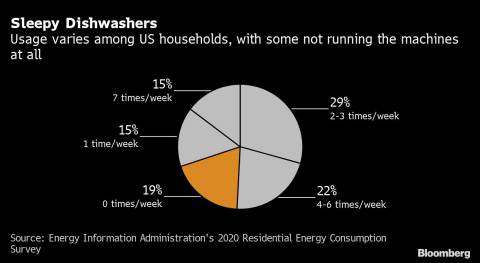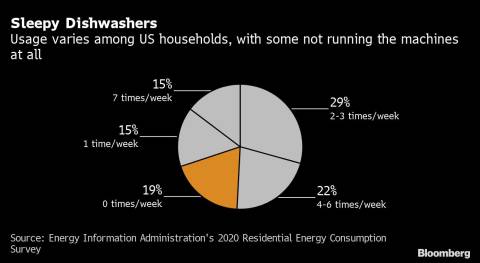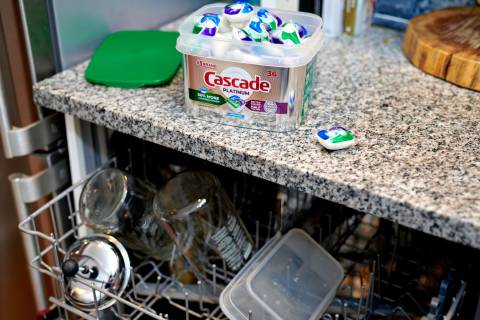(Bloomberg) -- Procter & Gamble Co. has spent a decade trying to remake itself. It shed weaker brands and thousands of jobs. It bolstered its supply chain. And now it wants to prove that it can reinvigorate some of its household names.

Take Cascade, a dishwasher detergent that is emblematic of many P&G brands. It’s big, with sales approaching $900 million, old at nearly 70 years and dominant in controlling two-thirds of the US market. But that makes it hard to grow. To really alter the trajectory of a business this size, P&G is trying to change consumer behavior — a major undertaking for any company.

“We call it waking up sleepy dishwashers,” said Marchoe Northern, who leads P&G’s North America home care unit.

Nearly one in five dishwashers in the US — totaling 17 million households — sit idle largely because people think they’re ineffective and wasteful. Both assumptions, it turns out, are wrong. Modern models only use about 10% of the water that cleaning dishes by hand does, according to the Environmental Protection Agency. P&G wants to take advantage of this fact, which has the added benefit of being touted by pro-environment groups, by pumping out a steady stream of ads highlighting it alongside Cascade product upgrades.
An initiative around saving water and money appears well-timed with the highest inflation in decades and a megadrought gripping the US Southwest. P&G also needs to prove it can maintain the momentum it gained during the past two years of the pandemic when more time at home helped sales rise 13% to $80.2 billion – its highest mark since 2012.
However, changing behavior is a monumental endeavor, particularly around a task as habit driven as dishwashing. Products have to vastly outperform what consumers are already using to prompt a switch, said Jennifer White Boehm, who follows industries including household goods at market research firm Mintel. And many shoppers are skeptical of big brands pitching sustainability.
A crucial part of P&G’s strategy takes place in a lab twenty minutes north of its downtown Cincinnati headquarters. Employees wearing safety goggles make mac and cheese and other sticky foods to test how well Cascade strips gunk off plates in the facility’s 72 dishwashers, which represent the models found in 80% of US homes.
Tubes that look like octopus arms connected to the machines allow scientists to adjust the water’s temperature, hardness and even the calcium to magnesium ratios. All this matters because one bad experience can be enough for people to stop using their dishwashers, said Morgan Eberhard, a P&G scientific communications manager.
About 20% of loads consumers run don’t come out as clean as expected, according to P&G. Mistakes include overstuffing the machine and accidentally blocking the detergent dispenser. Or maybe the cleaner isn’t powerful enough, the company said.
After years of studying consumer habits, Eberhard said that many Americans just don’t understand their dishwashers because they can’t see inside them when they are running. About seven years ago, she visited a house to do research and opened the machine mid-cycle to see if it had been loaded correctly. The homeowner rushed to stop her, fearing that gallons of water would flood the kitchen.
That wasn’t going to happen because dishwashers don’t fill up with water like a washing machine. Newer models that meet federal Energy Star standards can cut utility bills by $130 per year compared to handwashing. They also use fewer than four gallons of water per cycle, versus 42.4 gallons when cleaning the equivalent of a full dishwasher load in the sink, according to the EPA.
“The dishwasher is completely a black box,” Eberhard said.
When Cascade debuted in 1953, only 4% of households had the appliance, versus 73% in 2020. As P&G launched gels, additives and pods over the decades, it enticed customers with promises to make “yesterday’s mess virtually spotless.”
P&G first layered water conservation into ads around 2000 as dishwashers became more efficient and environmental concerns bubbled up. It went a step further in 2020 with the rollout of its “Do It Every Night” campaign.One ad featured Gen X celebrity couple Freddie Prinze Jr. and Sarah Michelle Gellar in a mock public service announcement about doing it every night — running the dishwasher to save water, energy and time, that is. Those benefits have become increasingly important as people spend more time at home, Barclays Plc. analyst Lauren Lieberman said.
The video highlights Cascade Platinum, P&G’s top of-the-line detergent that debuted in 2013. Its formula includes the company’s Dawn dish soap to get rid of grease and help cement the idea that pre-rinsing isn’t necessary — also part of its message on saving shoppers water and time.
Another cheeky ad shows an elderly couple saying they do it after dinner, “like clockwork.” Again, they’re talking about running the dishwasher with Cascade Platinum, dubbed “the surprising way to save water.”
The commercial has racked up 6.3 billion impressions since debuting in 2020, making it the third most-viewed ad in the home cleaning supplies and fresheners industry, according to measurement company iSpot.
Humor might be what is needed to get the masses to embrace conservation, said Will Sarni, a water strategy consultant. As many as 3.5 billion people around the world could experience scarcity by 2025, according to the World Resources Institute.
“Society is now numb to one more crisis,” Sarni said. “A softer touch to increase awareness that is sticky, engaging and thoughtful is going to have a better chance.”
However, even if the 17 million idle dishwashers started running four times a week, that would only save what all US households use roughly every five days, government data show.
After preaching that dishwashers save water, P&G debuted a campaign earlier this year that fills out the second half of its bet on changing habits. It’s a simple message about Cascade’s performance: “scrape, load and we’re done,” says the ad, which touts benefits such as a “built-in pre-rinse system.”
According to P&G’s Northern, the company wants Americans to have confidence in the dishwashers they’ve underestimated for so long.
“No fear of failure,” she said.
Editor’s note: For more on how consumer sectors are being disrupted by sustainability, read: Mushroom Leather Is Here. Will Shoppers Care? , Plant Milk Is Coming for Your Kids , The Battle for Your Toilet Paper Is On , Recycling Isn’t Going to Solve Plastic Waste. Enter Windex .
More stories like this are available on bloomberg.com
©2022 Bloomberg L.P.
Author: Daniela Sirtori-Cortina
